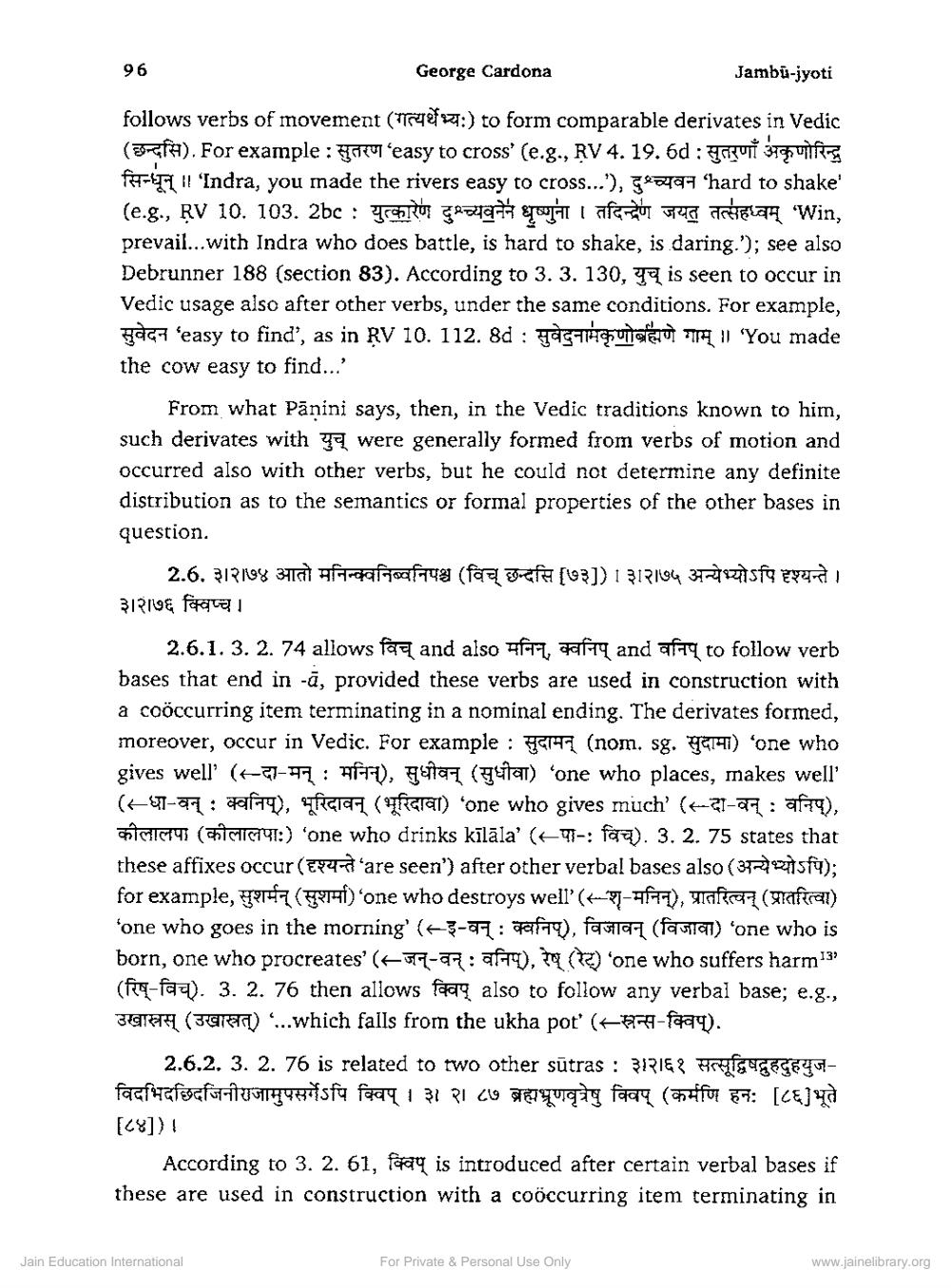________________
96
George Cardona
Jambu-jyoti
follows verbs of movement (गत्यर्थेभ्यः) to form comparable derivates in Vedic (छन्दसि). For example : सुतरण ‘easy to cross' (e.g., RV4.19.6d : सुतरणाँ अकृणोरिन्द्र सिन्धून् । 'Indra, you made the rivers easy to cross...'), दुश्च्य वन 'hard to shake' (e.g., RV 10. 103. 2bc : युत्कारेण दुश्च्यवनेन धृष्णुना । तदिन्द्रेण जयत तत्सहध्वम् 'Win, prevail...with Indra who does battle, is hard to shake, is daring.'); see also Debrunner 188 (section 83). According to 3. 3. 130, युच् is seen to occur in Vedic usage also after other verbs, under the same conditions. For example, सुवेदन 'easy to find', as in RV 10. 112. 8d : सुवेदनामकृणोब्रह्मणे गाम् | 'You made the cow easy to find...'
From what Pānini says, then, in the Vedic traditions known to him, such derivates with y were generally formed from verbs of motion and occurred also with other verbs, but he could not determine any definite distribution as to the semantics or formal properties of the other bases in question.
2.6. ३।२।७४ आतो मनिन्क्वनिब्वनिपश्च (विच् छन्दसि [७३]) 1 ३1२।७५ अन्येभ्योऽपि दृश्यन्ते । ३।२७६ क्विाच।
2.6.1. 3. 2. 74 allows विच् and also मनिन्, क्वनिप् and वनिप् to follow verb bases that end in -ā, provided these verbs are used in construction with a coöccurring item terminating in a nominal ending. The derivates formed,
moreover, occur in Vedic. For example : सुदामन् (nom. sg. सुदामा) 'one who gives well' (+-दा-मन् : मनिन्), सुधीवन् (सुधीवा) 'one who places, Imakes well' (-धा-वन् : क्वनिप्), भूरिदावन् (भूरिदावा) 'one who gives much' (e-दा-वन् : वनिप्), कीलालपा (कीलालपाः) 'one who drinks kilala' (-पा-: विच). 3.2.75 states that these affixes occur (दृश्यन्ते 'are seen') after other verbal bases also (अन्येभ्योऽपि); for example, सुशर्मन् (सुशर्मा) one who destroys well' (--'श-मनिन्), प्रातरित्वन् (प्रातरित्वा) 'one who goes in the morning' (-इ-वन् : क्वनिप्), विजावन् (विजावा) 'one who is born, one who procreates' (-जन्-वन् : वनिप्), रेष् (रेट्) 'one who suffers harm3' (रिष्-विच्). 3. 2. 76 then allows क्विप् also to follow any verbal base; e.g., उखास्त्रस (उखास्त्रत्) '...which falls from the ukha pot' (सन्स-क्विप).
2.6.2. 3. 2. 76 is related to two other sūtras : ३।२।६१ सत्सूद्विषQहदुहयुजविदभिदछिदजिनीराजामुपसर्गेऽपि क्विप् । ३१ २। ८७ ब्रह्मभ्रूणवृत्रेषु विवप् (कर्मणि हनः [८६] भूते [८४])।
According to 3. 2. 61, foray is introduced after certain verbal bases if these are used in construction with a coöccurring item terminating in
Jain Education International
For Private & Personal Use Only
www.jainelibrary.org




